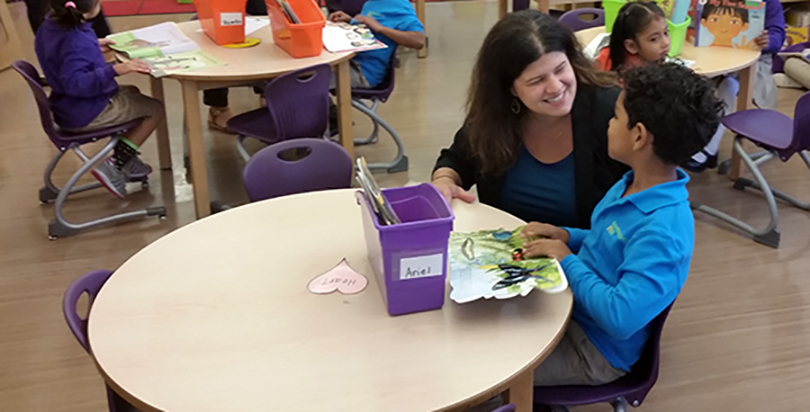NYC’s Haven Academy, a Bronx Breakthrough Serving Kids in Foster Care That Carmen Farina Has Yet to Visit

There are several must-stops on a tour of the country’s very best charter schools: In California, High Tech High schools are flat out striking, and Summit founder Diane Tavenner may be personally re-inventing American high schools.
In Texas’s Rio Grande Valley, seeing an IDEA school in action is inspiring (Take your passport; don’t ask why, just do it). Newark’s North Star Academy may have the busiest visit/scheduler in the country. Boston has too many great charters to choose from (Okay, Brooke is a personal favorite) and a KIPP school anywhere warrants a visit just to see its unique student culture in motion.
A new addition to the top of my personal must-see list: New York’s Mott Haven Academy. Who? That’s an understandable reaction.
For starters, Haven Academy has a decidedly unglamorous spot, located squarely in the nation’s most impoverished congressional district, the South Bronx. To get there, you take the 6 train to Brook Avenue, walk down the hill amidst the high rise projects and veer right just before colliding with the grimy Bruckner Expressway.
Once arrived (the building is great, by the way), some might consider the Haven Academy student body a bit, well, challenging. A third of the students are living in foster homes, another third are “involved” with the foster care system (aka: Preventive Services) and another third are drawn from the neighborhood.
On any given night, roughly a fifth of the students will go to sleep in homeless shelters.
The attachment disorders and impulse control issues dealt with by the staff in a single class period rival what a suburban teacher might see over the span of a decade. And yet, when you walk from class to class, Haven Academy has one of the most positive cultures I’ve ever seen.
The academic record at Haven Academy, which opened in 2008, is impressive, far better than the traditional school across the street, and there should be no comparison. Haven Academy’s annual student return rate (95 percent) is striking, considering both this neighborhood and the stunning transience rate of the city’s foster care population.
Actually, that’s a core part of their philosophy: Regardless of where a guardian/foster parent moves the child doesn’t have to go to the new neighborhood school; they can return to Haven Academy, and they do.
Oddly, the sad thing about Haven Academy is not the struggles its students are facing; they seem to be doing pretty well, especially when compared to their foster care counterparts who end up in traditional public schools. (The statistics in those schools tend to be grim; nearly half get shunted into special education, mostly because of their transience rate.)
What’s sad is that no one appears to be paying attention to Haven Academy’s success. Possibly because of Mayor de Blasio’s enmity toward charter schools, his chancellor, Carmen Farina, has not been by to visit. (An Oct. 26 query to Farina’s press office about a possible visit remains unanswered) In theory, this should be Farina’s favorite kind of charter – the kind that doesn’t threaten her traditional schools. But there’s been no visit, and no accolades.
The Haven Academy team has no objections to other charter schools copying their model, but the numbers far exceed a charter-only solution. In New York City alone there are 11,000 children involved with the foster care system. What charter, or group of charters, could possibly make a dent in those soaring numbers? Educators concerned about these kids desperately need Farina and other big district chiefs to pay attention: There really are better ways to educate foster care children.
“Haven Academy is special because we’re all a family,” said fifth-grader Tatiana, who lives with her “aunty.” Fourth grader Ruby, who lives with her mother (thus falling into the second category – students engaged with the child welfare system, but not in a foster home), chimes in with, “I don’t live with my dad.” Principal Jessica Nauiokas quickly adds, “That’s okay, lots of people live with different family members.” Ruby smiles and nods in agreement.
“I feel like one of our responsibilities is to normalize the experience of a child welfare child or a child in foster care has by being here,” said Nauiokas. “And we do that in a number of ways. We don’t usually refer to parents as parents — we usually say ‘families’ because many students are not living with a parent. They’re living with a foster parent, a grandma, an aunt or uncle. So that’s one piece. We make sure that the literature in the classroom reflects all types of families and also talks about concepts and themes like my family lives in a shelter.”
The best part of Haven Academy, agree both Ruby and Tatiana, are the trips, such as Camp Felix, a sleep-away camp in upstate New York that’s filled with campfires, swimming pools, rock climbing, bunk beds, all that good stuff – good stuff most of these kids are experiencing for the very first time.
The students often talk to one another about their family situations, but for these students, the out-of-the-ordinary becomes the ordinary, so that’s rarely a problem. Often a problem, however, is how a child behaves the day before a big change — moving to a new temporary foster home, for example. Often more traumatic: reuniting with the birth family.
“So many of our students are used to the idea that kids have a [government] agency involved in their life,” said Nauiokas. “So when a student says I went to the agency the whole class knows she went to the agency because that’s where she visits her mom or that’s where she visits her father or they’ve got appointments there. So through all of those things I think we help make it easier for our children just to be able to share natural components of their day and not feel stigmatized about it.”
There are certain “big event’’ days staffers know about, and are quick to step in to assist with emotional issues. As Nauiokas pointed out, this is not a job for first-year teachers.
“For some students they’re very excited to go home to their biological parent and so you’ll see behaviors improve. For other students they’re very skeptical about that because they remember either the abuse or the neglect that occurred when they were living with that caregiver. And so then you’ll see behaviors change and you’ll see maybe kids being withdrawn or kids acting out. Sometimes they’re afraid to say goodbye to the foster parent, so it could be any number of emotions; it really depends on the child’s unique situation.”
Perhaps the most telling fact about Haven Academy is its popularity with the surrounding South Bronx neighborhood. A third of the student body has nothing to do with the foster care system. During an early community meeting required to win a charter, there were skeptical questions about mixing in neighborhood kids. “Why would other families want to send their kids there?” asked one neighborhood official. That’s never been a problem.
“Surprisingly, we haven’t had any resistance to that,” said Nauiokas. “We have over 400 new applications from community families every year. I think folks just recognize that it’s a school in the community that’s getting results. They see the building, which is fresh and clean, and they see how well behaved our students are in the park, and they say, ‘That’s a place I’d want my children want to be.’”


Mott Haven Academy students Tatiana and Ruby. (Photos by Richard Whitmire)
There are multiple practices at Haven Academy that make it a must-visit. Usually, high performing charter schools get that way because their leaders visit other great charters and borrow heavily. But that can’t always work at Haven Academy.
Take the common KIPP-style practice of handing out pretend money (redeemable at at the school supply store) for good behavior, or having it taken it away for bad behavior. Works great, unless you’re Haven Academy, where kids may be suffering from attachment disorders or have been victims of abuse and neglect. In this environment, that kind of “economy” can backfire, said New York Foundling CEO Bill Baccaglini, a key figure behind wrapping the charter school around the Foundling’s South Bronx operation, making it a one-stop social services operation. “It triggers all these emotions about ‘I had it, and I lost it’ type of thing.”
Therefore, Nauiokas had to invent her own system for instilling a positive student culture. Another example: Unlike most charter leaders, who eagerly recruit top candidates from Teach for America, Nauiokas has to resist. What fresh college graduate could possibly navigate in a school this sophisticated? TFA alums are more than welcome (there are four, including Nauiokas) but no first-year recruits.
Nauiokas wasn’t totally on her own in inventing the model. From E.L. Haynes charter school in Washington, D.C., she borrowed parts of their project-based learning. From watching KIPP’s famed leadership training, she learned how to train teachers to “sweat the small stuff.” From New York’s Ethical Culture Fieldston School, she borrowed strategies on moral development.
Understandably, the staff here is a little different. The maximum class size is 25, and there are two teachers in every class. Plus, the school has two behavior interventionists, two social workers, a counselor and a special education specialist. (The school serves 330 Pre-K through fifth graders).
But what’s interesting in walking from class to class is that you can’t tell who’s who. It’s part of the Haven style. “We need our teachers to empathize or they are not going to be able to educate this population,” said Baccaglini. “But the minute they become the social worker we lose the class. They are there to be teachers. So they have to empathize, not sympathize, or we’ll never move these young scholars down the road.”
Given the school’s long track record, there’s a lot of certainty that the model is right. In fact, the Haven Academy leaders are confident enough to start planning a middle school. And Nauiokas is getting noticed: Recently she was honored with a national role advising the federal Education Department on school leadership.
But in the end, what difference does this bold and successful experiment make if nobody shows any interest in replicating it?
Maybe I should repeat the directions: Take the 6 train to…
Get stories like these delivered straight to your inbox. Sign up for The 74 Newsletter

;)
